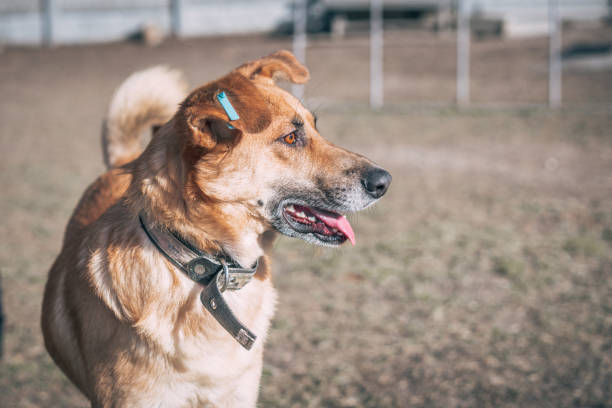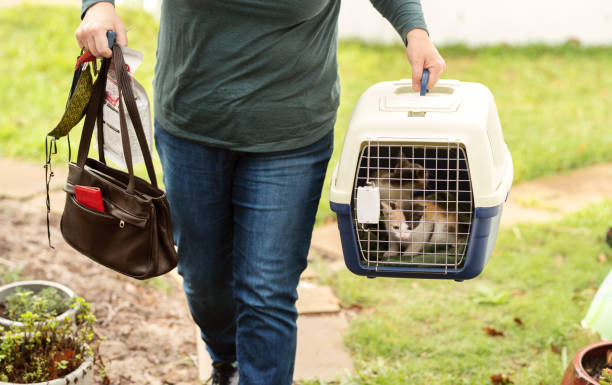This post contains affiliate links, we'll earn compensation if you make a purchase using them at no additional cost to you 😊
Globally, over 10 million dogs are lost every year, turning joyful homes into worried households.
It is not clear why a dog runs away. The reasons for a dog to go missing vary from boredom to hunting instincts.
Thanks to technologies like tracking tags, microchips, and GPS trackers, 15% of lost pets are reunited with their owners.
In this article, I have researched and collected some note-worthy statistics about how many dogs are lost and found and ways to bring them back to their homes.
Lost Dogs Statistics For 2024 (Overview)
A five-year investigation on lost pets by the ASPCA revealed numerous startling figures.
In the past five years, there have been much fewer lost cats and dogs, and a lot of the lost dogs have been brought back to their owners.
Other information from the survey includes,
- Just 15 percent of the total pet owners experienced a pet loss.
- 6% of dog owners got their dogs from animal shelters.
- The survey also revealed that 15% of canines were brought back to their owners by means of an identification tag.
- 16% of lost pets eventually return to their owners.
- Also, 90% of the time, your pet will be found in your area in less than 12 hours.
How Many Dogs Disappear Each Year?
Around 10 million dogs and cats are reported lost or stolen in the United States each year, according to the American Humane Association. Yet, the approximate number of canines reported missing is 6,70,000.
In the previous five years, dogs or cats were owned by 1,015 households. 817 of these families had dogs.

How Many Missing Dogs Find Their Way Back Home?
According to the Lost Pet Study, 20% of dogs return home on their own.
How Many Lost Pets Never Find Their Way Back Home?
Around 7% of dogs have not ever returned to their owners’ homes to visit them. The other 93% are either driven home or make their own way back.
How Many Lost Dog Reports Have There Been?
In the United States, it is estimated that over their lifetimes, one-third of all dogs go missing.
Yet, among those who discovered a pet and made an effort to track down the owner by getting in touch with an animal shelter or publishing a notice in the neighborhood paper.
Only 38% of these seekers were successful in reuniting animals with their people, with dogs being significantly more likely (46%) than cats (3%) to do so.
How Many Lost Pets Are Found With A Dog GPS Tracker?
Recoveries are impossible because just 58.1% of microchipped dogs were reported to the relevant organizations.

93 percent of all missing pet instances result in the creature’s return to its owner. Due to the fact that they are equipped with tags, microchips, and GPS trackers, about 15% of lost pets are reunited with their owners.
The most frequent means for locating dogs were searching the area and having them come back on their own; 14% were located thanks to an identification tag.
Cats were less likely than dogs to go missing multiple times.
Some True Facts about Lost Dogs Statistics
Here are some true facts based on thorough research about lost dogs:
In a 5-year period, 15% of pet parents lose their dog friends
The amount of pets that go missing or are lost every year is consistent across the board.
Based on actual data, the most accurate estimates we discovered put the figure at around 15%. You can see from the statistics that a number of things are involved.
Every shelter puts to death over 1.5 million lost animals
The majority of individuals who find a lost pet don’t give it to a shelter. There is no need to sugarcoat things.
We are all well aware that many animals are put to death. These animal agencies have no other option, according to the statistics.
Although regrettable, it is a reality. It is a statistic that nobody in the business wants to acknowledge. You can be certain of that.
Information for about 35.4% of microchipped pets entering shelters was inaccurate, which avoided a reunion with their parents.
Among all the data we looked into, we have to admit that this one was among the most heartbreaking.
One of the best methods to safeguard your pet is to microchip it. It is practically worthless for individuals who want to assist in reuniting a dog or cat with its owner if you don’t preserve your contact information. We regret including this statistic on our list.
What are the chances of finding your lost dog?
Although the majority of lost dogs might ultimately be able to return home, it’s considerably more likely that they will be found and taken in by a rescuer.
The rationale is that it is less typical to encounter a roving pet dog than a roving pet cat. Yet, 93% of missing dogs are found alive, according to Lost Pet Research & Recovery.
The American Veterinary Medical Association found that in 21.9% of cases, dogs without microchips were returned to their owners.
But, if the dog is chipped, the odds of locating it increase as 52.2% of dogs were reclaimed from around 1000 kilometers distant.
(As per the ASPCA)
Also, there were variations in how the lost cats and dogs were found. Only 6% of dog owners discovered their lost dogs at a shelter.
How To Locate Lost Pets And Bring Them Back To Their Homes?
Your animal will always have a permanent ID if you choose to microchip it. Keep in mind that a pet’s microchip is only useful if the data is up to date.

So, as soon as you change your phone number or address, make sure to update your pet’s microchip.
Additionally, ask the veterinarian to scan your pet’s microchip when you are there for an examination if you’re not sure what contact details are shown on it.
Here are some actions you can do if your pet does go lost in an effort to locate your cherished companion:
1. Do a Full House and Property Search
- Once you’ve noticed your pet is missing, talk to any housemates or family members and ask where they last saw your pet.
- Spend some time thoroughly searching the house, looking in corners, closets, and beneath beds. Your pet could be napping inside the house, simply tucked away.
- If your pet is driven by food, shake the container containing their food or treats to gain their attention.
- If your pet isn’t inside the house, look around the neighborhood. Check beneath decks, by windows, in sheds, and in bushes. Some animals run away and hide right away.
- Go slowly around the area to see if you can locate them there. Cats usually wander around at dusk and dawn, looking for a secure place to hide during the day.
- Knock on doors with a recent photo to determine whether anyone saw them.
2. Get in touch with Lost & Found and Animal Welfare organizations
- Always get in touch with the city’s animal control services, shelters, rescues, or vet clinics.
- If your pet was wandering around the private property, there’s a chance someone saw them and took them in for surrender.
- Bring new images to the real location so they can be distributed there, if at all possible. The more individuals who are aware of your search for your pet, the safer.
3. Make a point to use social media
- With various online community networks or pet-loss organizations, social media is a potent tool.
- Post something on any social media platform for a short while.
- Also, if you feel comfortable doing so, include a phone number and a photo of the animal. Ask any page admins if they would be willing to let their members know about your pet.
4. Distribute “Lost Dog flyers” across the neighborhood
- Flyers give the neighborhood’s residents an immediate glimpse of your pet, despite the fact that they may appear to be a dated technique.
- Connecting to one another is very straightforward because the majority of individuals carry cell phones. Add a thorough photo, the pet’s name, contact information, and phone number.
- Include any rewards you’re giving away in the flyer.
- Add a headline that is big, bold, and in a readable typeface.
- When your pet is inside, keep track of the flyers you’ve distributed and remove them permanently from the community.
5. Speak with local residents
- Posting flyers throughout your area is a good place to start, but it also helps to distribute them in places where people can gather.
- Consider distributing a flyer to your neighborhood’s pet shops, groomers, vets, laundromats, and other busy places. Furthermore useful are parks and schools, particularly if your pet is amiable.
- Make some flyers just for children because they are frequently better observers than grownups, particularly when it comes to animals.
There are still issues with pets today for several reasons, including:
Following are the several reasons for issues that occur while recovering pets even today:
1. Technology Limitations
Many technologies were created, promoted, and offered to pet owners in the last few decades to solve the issue of lost pets, but little progress has been made.
Pet owners have a wide range of choices for securing their animals; a few are more effective than others, whereas others are completely useless, including electronic collars or fences, wireless collars, QR code tags, RFID technology, and tracking devices.
2. Chances of Collars Falling
There are high chances of a dog collar falling off of your dog while wandering around after getting lost.
Dogs tend to get into territorial fights after getting lost with other pets or dogs. Hence, dog owners can’t totally rely on dog collars, even if they are wireless, GPS, or other smart collars.
3. The Data Collection Problem
In the end, the Pet problem is a data problem. Pet care specialists lack the ability to get raw information as well as the capacity to assemble it all.
There are numerous Practice Information Management Systems with additional choices for software for managing shelters. Most of the time, everything functions offline, and data cannot be shared between many programs.
Related read :
Final Verdict! Lost Dogs Statistics (2024)
According to our overall findings, 14% of dogs in the US lost their owners at least once over a five-year period, as reported by the National Center for Biotechnology Information.
7% of dogs’ owners were never found, according to statistics.
In addition, canines were most frequently located by actively scouring the neighborhood, while creatures like cats most frequently returned home on their own.
In order to resolve the issue, strategies for reconnecting pets with their owners, such as collars and ID tags or humane trapping, may be necessary.
If a dog owner’s dog becomes lost, veterinarians and animal welfare professionals can be extremely helpful. Also, help can be given by instructing the owners on how to search actively for their lost pets.
So this was it on the lost dogs’ statistics from our side. If you liked the article and found it insightful, leave feedback in the comments below.
FAQs: Lost Dogs Statistics
Dogs are renowned for their propensity to turn around and go back to a beloved house or person.
Most specialists on animal behavior believe that animals’ keen sense of smell has a significant role in how well they can navigate.
According to statistics, the majority of missing pets are found within 30 days. Yet, the length of time depends significantly on whether it’s a dog or a cat. A wandering dog will typically attract attention and even attempts to aid.
Young, strong, and large dogs can run for five miles or more. Tiny dogs could have a maximum range of half a mile.
Include your family or friends in your search. To get your dog out of hiding, bring along one of their favorite treats or toys.
To lure your dog with familiar scents, leave your filthy items or your dog’s blanket outside.

